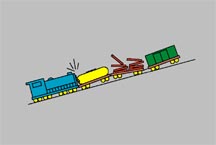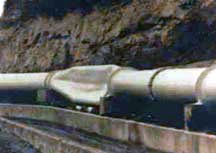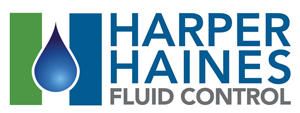Harper International* (dissolved 2012) Article 6275: System Surges
Prevent a Train Wreck in Your Water System!
Minimizing slam and water hammer damage

So you think it’s impossible for a runaway train to wreck your pipes? Think again!
The hydro-pneumatic tank puts the break on runaway water by cushioning your system during violent water hammer conditions. Also called a surge tank or, in some cases, a bladder tank, the hydro-pneumatic tank uses either an independent source of air to maintain the tank, or a flexing butyl barrier – a bladder – that separates the stored water from the captured pressure-control air cushion.
But surge tanks mitigate water hammer conditions only if you select and size the tank properly. Key selection criteria include sufficient tank capacity and proper integration with your entire system. To choose the right tank, you need to ask the right questions.
How surge tanks work
Hydro-pneumatic tanks are designed for water storage. These tanks are used for commercial and industrial well and water systems, booster systems, irrigation, surge protection or other potable water applications.
The density of water is 800 times greater than the density of air. As a result, air is compressible, while water is not. The hydro-pneumatic tank takes advantage of the vastly different densities of water and air, using compressed air to cushion water stored in the surge tank. Air pressure in the tank will vary as the volume of water rises and falls, based on system demand. System surges will accelerate and amplify this action, based on the origin, direction, and velocity of the system surge.
An improperly sized tank won’t put the brake on surge
Sizing a hydro-pneumatic tank can be difficult, and specifications frequently request a tank that is too small for the system. That’s like putting truck breaks on a freight train.
At Harper we work closely with engineers to properly size the tank. A system may need a much larger tank than originally anticipated by designers. As a rule of thumb, only 13% of total tank volume is available for water storage. Harper International helps clients maximize their effective storage capacity by properly integrating the tank as part of a larger pressure control system.
A waterlogged tank can make the brakes fail
To prevent tank waterlog, it is necessary to specify the correct tank size and include a reliable air source, be it bladder or compressor system. Incorrect system maintenance will evidence itself in a change in the air-to-water ratio. Once this occurs, the effective storage capacity will decrease.
Insufficient tank storage capacity triggers excessive pump cycling, which wears out pumps and other components prematurely. Excessive pumping can also raise energy costs by triggering peak demand charges. That’s a train wreck to your operating budget.
Many pumping systems now use components with variable frequency drive (VFD), which permits slow or soft starts to manage peak energy demand charges. However, using VFD pumps with hydro-pneumatic tanks is tricky. For example, VFD pumps may not allow sufficient tank capacity due to the programming and system design. The system needs a sufficient air cushion to reduce pump cycling for an extended period at night. Harper International helps engineers review the compatibility of VFD with a system’s surge tanks.
How do power outages increase risk?
We’re back to the potential train wreck in your pipes. Even short power failures can trigger catastrophic events in a water system.

Whenever a system goes negative, a vacuum forms, water reverses direction and gains velocity. This causes pipes to flex or move and other equipment to fail in a water hammer event. In its worst form, column separation occurs, compounding the system violence.
Power outages are becoming frequent events. This situation is leading both municipal water systems and commercial properties to review their surge protection systems, which could include hydro-pneumatic tanks, along with surge and air-valving, to greatly reduce surge and vacuum formation.
Storing water during periods of low activity, a surge tank can be engineered to deliver enough water during a power failure to minimize a negative condition. But if the surge tank’s effective storage capacity is too small or if the tank does not work well with the pumps and other system parts, the tank will fail to do its job properly in a catastrophic water hammer event, perhaps damaging the water system. Harper International has the expertise to help you select the proper surge tank and integrate it with your system.
The bigger the train, the worse the wreck
The force of a water hammer event is amplified when a system operates very long runs of pipe. Pipe runs exceeding 20 miles are common in municipal water systems in the West and Midwest, where water systems have long used surge tanks to minimize water hammer conditions.
Historically the water systems in the Northeast seldom experienced this problem, due to the shorter distance of water mains. But as systems become more inter-connected, they dramatically lengthen their runs of pipe, which puts them newly at risk of violent water hammer events.
125 Old Gate Lane, Milford, CT 06460
Telephone: 203.693.3740 * Fax: 203.547.6092

